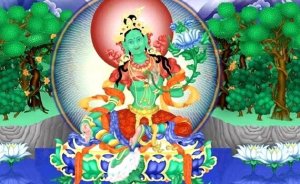The Green Tara Mantra: A Liberating Practice

The Green Tara mantra comes from the most popular goddess of Buddhism. Green Tara is the goddess of universal compassion, enlightenment, and virtuous performances. They say she’s the mother of all Buddhas.
The word Tara means “liberating”. According to Buddhist beliefs, it frees people mainly from their fears of external threats. Among them, says the tradition, there’s the fear of elephants, lions, fire, snakes, thieves, stormy waters, slavery, and evil spirits. Therefore, the Green Tara mantra is a ritual to conjure up all of those dangers.
The Green Tara mantra also protects against internal dangers: pride, ignorance, jealousy, hatred, stubbornness, attachment, disturbing doubts, and greed. For Buddhists, this is a very powerful mantra that offers tranquility and safety.
The meaning of the Green Tara mantra
A mantra is a group of syllables, phonemes, or words that, according to certain beliefs, have a psychological or spiritual power. Its etymological meaning is “mental instrument”. Each mantra induces a certain state of consciousness or mood. The Green Tara mantra is used to face fear and insecurity.

Now, the following words and syllables compose the Green Tara mantra: “om tare tuttare ture soha“. It refers to Tara, the goddess of universal compassion and the color green, which is the color of vitality for Buddhists. Let’s talk more about the meaning of those words:
- Om: It has to do with the body, the mind, and the approach to universal divinity.
- Tare: It’s the liberation of the sufferings, feelings, and inferior strength.
- Tuttare: It represents protection against internal and external dangers.
- Ture: It’s a protection against physical diseases and a peace-generating word.
- Soha: It represents the long-term action of protection against internal and external dangers.
Meditation and the Green Tara mantra
The Green Tara mantra has a great meaning for Buddhists. In the West, there are also many people who practice this mantra since it’s a way for them to feel calm and relaxed. Most of them don’t give it the same connotation as Buddhists do. However, they still turn to it to strengthen themselves.

The Buddhist tradition says that the best way to pronounce this mantra is through meditation. It points out that there are certain steps that are necessary for this mantra to be fully effective:
- Looking for a quiet place. Sitting down, closing your eyes, and breathing.
- Thinking about the problem you wish to solve.
- Focusing on anguish and fear disappearing.
- Repeating the mantra out loud several times: “Om tare tuttare ture soha”.
- Mentally visualizing a green sphere while repeating the mantra and breathing deeply.
- When you feel a sensation of calmness, keep yourself breathing for a while before going back to regular activities.
Does it really work?
It’s quite difficult to establish the real effectiveness of these kinds of rituals. It’s known that repeating evocative words have a calming and relaxing effect on people. One way or another, they help the brain vibrate in a much calmer frequency.
What is certain is that we program ourselves to approach or stay away from certain experiences. We also organize different systems of interpretation for each one. We sometimes do it consciously, but most of the time we don’t realize it. Therefore, our attitude brings us closer to certain experiences and distances us from others. This is why we interpret what happens to us in different ways.

To summarize, if a person thinks that a ritual like the Green Tara mantra has a special and powerful meaning, that’s the way it’s going to be for them. On the other hand, if a person’s very skeptical about it, it probably won’t have any effect on them. Remember that the human mind is quite complex and profound and a mysterious world that’s capable of anything.
The Green Tara mantra comes from the most popular goddess of Buddhism. Green Tara is the goddess of universal compassion, enlightenment, and virtuous performances. They say she’s the mother of all Buddhas.
The word Tara means “liberating”. According to Buddhist beliefs, it frees people mainly from their fears of external threats. Among them, says the tradition, there’s the fear of elephants, lions, fire, snakes, thieves, stormy waters, slavery, and evil spirits. Therefore, the Green Tara mantra is a ritual to conjure up all of those dangers.
The Green Tara mantra also protects against internal dangers: pride, ignorance, jealousy, hatred, stubbornness, attachment, disturbing doubts, and greed. For Buddhists, this is a very powerful mantra that offers tranquility and safety.
The meaning of the Green Tara mantra
A mantra is a group of syllables, phonemes, or words that, according to certain beliefs, have a psychological or spiritual power. Its etymological meaning is “mental instrument”. Each mantra induces a certain state of consciousness or mood. The Green Tara mantra is used to face fear and insecurity.

Now, the following words and syllables compose the Green Tara mantra: “om tare tuttare ture soha“. It refers to Tara, the goddess of universal compassion and the color green, which is the color of vitality for Buddhists. Let’s talk more about the meaning of those words:
- Om: It has to do with the body, the mind, and the approach to universal divinity.
- Tare: It’s the liberation of the sufferings, feelings, and inferior strength.
- Tuttare: It represents protection against internal and external dangers.
- Ture: It’s a protection against physical diseases and a peace-generating word.
- Soha: It represents the long-term action of protection against internal and external dangers.
Meditation and the Green Tara mantra
The Green Tara mantra has a great meaning for Buddhists. In the West, there are also many people who practice this mantra since it’s a way for them to feel calm and relaxed. Most of them don’t give it the same connotation as Buddhists do. However, they still turn to it to strengthen themselves.

The Buddhist tradition says that the best way to pronounce this mantra is through meditation. It points out that there are certain steps that are necessary for this mantra to be fully effective:
- Looking for a quiet place. Sitting down, closing your eyes, and breathing.
- Thinking about the problem you wish to solve.
- Focusing on anguish and fear disappearing.
- Repeating the mantra out loud several times: “Om tare tuttare ture soha”.
- Mentally visualizing a green sphere while repeating the mantra and breathing deeply.
- When you feel a sensation of calmness, keep yourself breathing for a while before going back to regular activities.
Does it really work?
It’s quite difficult to establish the real effectiveness of these kinds of rituals. It’s known that repeating evocative words have a calming and relaxing effect on people. One way or another, they help the brain vibrate in a much calmer frequency.
What is certain is that we program ourselves to approach or stay away from certain experiences. We also organize different systems of interpretation for each one. We sometimes do it consciously, but most of the time we don’t realize it. Therefore, our attitude brings us closer to certain experiences and distances us from others. This is why we interpret what happens to us in different ways.

To summarize, if a person thinks that a ritual like the Green Tara mantra has a special and powerful meaning, that’s the way it’s going to be for them. On the other hand, if a person’s very skeptical about it, it probably won’t have any effect on them. Remember that the human mind is quite complex and profound and a mysterious world that’s capable of anything.
All cited sources were thoroughly reviewed by our team to ensure their quality, reliability, currency, and validity. The bibliography of this article was considered reliable and of academic or scientific accuracy.
- Jacobs, Joseph (2016) Fábulas y leyendas de la India. Quaterni
- Chu, LC (2010). Los beneficios de la meditación frente a la inteligencia emocional, el estrés percibido y la salud mental negativa. Estrés y salud , 26 (2), 169-180. https://doi.org/10.1002/smi.1289
This text is provided for informational purposes only and does not replace consultation with a professional. If in doubt, consult your specialist.







